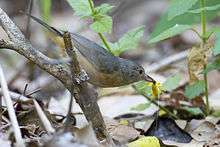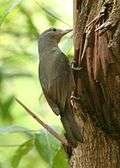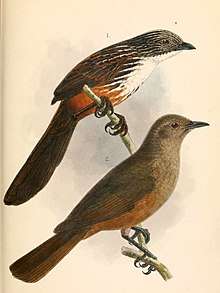Shrikethrush
A shrikethrush, also spelt shrike-thrush, is any one of five species of songbird that is a member of the genus Colluricincla. They have nondescript, predominantly brown or grey, plumage, but are accomplished singers,[1] their calls described as "strong, mellow and beautiful."[2] Shrikethrushes are generally insectivorous, though have been recorded eating molluscs and berries. They build cup-shaped nests in the forks of trees.[3]
| Shrikethrushes | |
|---|---|
.jpg) | |
| Grey shrikethrush (C. harmonica) | |
| Scientific classification | |
| Kingdom: | Animalia |
| Phylum: | Chordata |
| Class: | Aves |
| Order: | Passeriformes |
| Family: | Pachycephalidae |
| Subfamily: | Pachycephalinae |
| Genus: | Colluricincla Vigors & Horsfield, 1827 |
| Synonyms | |
| |
Taxonomy and systematics
Nicholas Aylward Vigors and Thomas Horsfield described the genus in 1827, coining the genus name from the Ancient Greek words collurio "shrike" and cinclos "thrush". Noting the beak, they thought it related to shrikes or vangas, though its form was reminiscent of thrushes.[4] Shrikethrushes were commonly known as colluricinclas in the 19th century, but their current name was in use by the late 19th century.[5]
Molecular studies by Norman and colleagues in 2009 and Jønsson and colleagues in 2010 show the shrikethrushes to lie within the whistler family Pachycephalidae.[6][7] Formerly, some authorities classified the shrikethrushes in their own family Colluricinclidae.
Molecular dating suggests the shrikethrushes diverged from the common ancestor of the genus Pseudorectes (their closest relatives) in the mid-Pliocene around 3 million years ago, and that this combined lineage had diverged from the ancestor of the other members of the Pachycephalidae around 5 million years ago in the early Pliocene.[7] The Sangihe shrikethrush was found to be more closely related to the maroon-backed whistler and hence shifted to the genus Coracornis.[7] Genetic investigations of New Guinea populations of the little shrikethrush indicate high levels of genetic divergence, suggesting it may comprise more than one species.[8]
Extant species
The genus Colluricincla contains the following eleven species:
| Species of Colluricincla | |||
|---|---|---|---|
| Common and binomial names | Image | Description | Range |
| Bower's shrikethrush (Colluricincla boweri) |  |
Far North Queensland | |
| Sooty shrikethrush (Colluricincla tenebrosa) | Mountains of central New Guinea | ||
| Arafura shrikethrush (Colluricincla megarhyncha) | _(31301484561).jpg) |
New Guinea and Australia | |
| Variable shrikethrush (Colluricincla fortis) | New Guinea | ||
| Waigeo shrikethrush (Colluricincla affinis) | Waigeo Island, New Guinea | ||
| Mamberamo shrikethrush (Colluricincla obscura) | New Guinea | ||
| Tagula shrikethrush (Colluricincla discolor) | Tagula Island, New Guinea | ||
| Sepik-Ramu shrikethrush (Colluricincla tappenbecki) | New Guinea | ||
| Rufous shrikethrush (Colluricincla rufogaster) |  |
New Guinea and Australia | |
| Grey shrikethrush (Colluricincla harmonica) |  |
Throughout mainland Australia and Tasmania | |
| Sandstone shrikethrush (Colluricincla woodwardi) |  |
Northern Territory into western Queensland and Western Australia | |
Former species
Formerly, some authorities also considered the following species (or subspecies) as species within the genus Colluricincla:
- Sangihe shrikethrush (as Colluricincla sanghirensis)[9]
- Island whistler (as Myiolestes phaionotus)[10]
- Yellow-throated whistler (as Myiolestes macrorhynchus)[11]
- Biak whistler (as Colluricincla melanorhyncha)
- Morningbird (as Colluricincla tenebrosa)[12]
- White-bellied pitohui (as Colluricincla incerta)[13]
- Rusty pitohui (as Colluricincla ferruginea)[14]
- Fiji shrikebill (as Myiolestes vitiensis)[15]
- Fiji shrikebill (buensis) (as Myiolestes buensis)[16]
- Futuna lesser shrikebill (as Myiolestes fortunae)[17]
- Fiji shrikebill (heinei) (as Myiolestes heinei)[18]
References
- Slater, Peter (1974). A Field Guide to Australian Birds: Passerines. Adelaide, South Australia: Rigby. p. 192. ISBN 0-85179-813-6.
- Bruce Campbell; Elizabeth Lack (2010). A Dictionary of Birds. Bloomsbury Publishing. p. 390. ISBN 9781408138380.
- Gould, John (1848). An introduction to the Birds of Australia. Published by the author. p. 38.
- Vigors, Nicholas Aylward; Horsfield, Thomas (1827). "A Description of the Australian Birds in the Collection of the Linnean Society; with an Attempt at Arranging them According to their Natural Affinities". Transactions of the Linnean Society of London. 15: 170–331 [213]. doi:10.1111/j.1095-8339.1826.tb00115.x.
- Gray, Jeannie; Fraser, Ian (2013). Australian Bird Names: A Complete Guide. Csiro Publishing. ISBN 978-0-643-10471-6.
- Norman, Janette A.; Ericson, Per G.; Jønsson, Knud A.; Fjeldså, Jon; Christidis, Les (2009). "A multi-gene phylogeny reveals novel relationships for aberrant genera of Australo-Papuan core Corvoidea and polyphyly of the Pachycephalidae and Psophodidae (Aves: Passeriformes)". Molecular Phylogenetics and Evolution. 52 (2): 488–97. doi:10.1016/j.ympev.2009.03.019. PMID 19341806.
- Jønsson, Knud A.; Bowie, Rauri C. K.; Moyle, Robert G.; Christidis, Les; Norman, Janette A.; Benz, Brett W.; Fjeldså, Jon (2010). "Historical biogeography of an Indo-Pacific passerine bird family (Pachycephalidae): different colonization patterns in the Indonesian and Melanesian archipelagos". Journal of Biogeography. 37 (2): 245–57. doi:10.1111/j.1365-2699.2009.02220.x.
- Deiner, Kristy; Lemmon, Alan R.; Mack, Andrew L.; Fleischer, Robert C.; Dumbacher, John P. (2011). "A Passerine Bird's Evolution Corroborates the Geologic History of the Island of New Guinea". PLOS ONE. 6 (5): e19479. doi:10.1371/journal.pone.0019479. PMC 3089620. PMID 21573115.
- "Coracornis sanghirensis - Avibase". avibase.bsc-eoc.org. Retrieved 2017-01-29.
- "Pachycephala phaionota - Avibase". avibase.bsc-eoc.org. Retrieved 2017-01-31.
- "Pachycephala macrorhyncha - Avibase". avibase.bsc-eoc.org. Retrieved 2017-02-02.
- "Pachycephala tenebrosa - Avibase". avibase.bsc-eoc.org. Retrieved 2017-02-13.
- "Pseudorectes incertus - Avibase". avibase.bsc-eoc.org. Retrieved 2017-02-13.
- "Pseudorectes ferrugineus - Avibase". avibase.bsc-eoc.org. Retrieved 2017-02-14.
- "Clytorhynchus vitiensis [vitiensis, incl. fortunae, powelli] - Avibase". avibase.bsc-eoc.org. Retrieved 2017-01-12.
- "Clytorhynchus vitiensis buensis - Avibase". avibase.bsc-eoc.org. Retrieved 2017-01-12.
- "Clytorhynchus vitiensis fortunae - Avibase". avibase.bsc-eoc.org. Retrieved 2017-01-12.
- "Clytorhynchus vitiensis heinei - Avibase". avibase.bsc-eoc.org. Retrieved 2017-01-12.